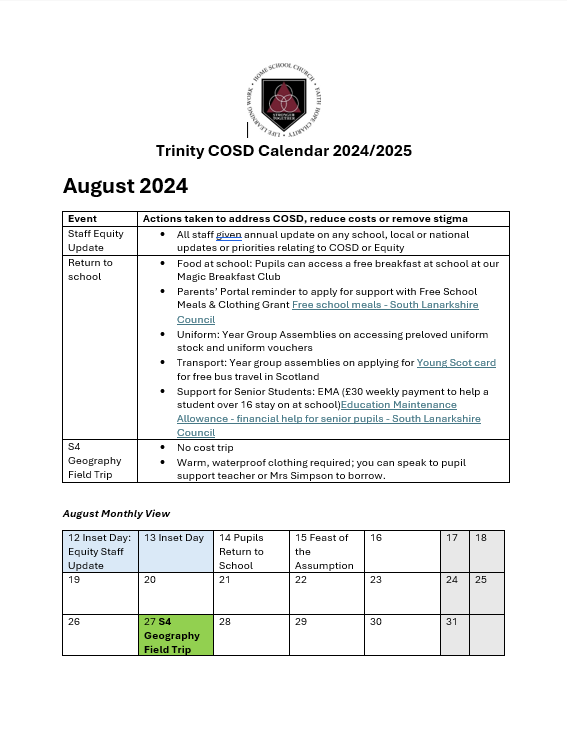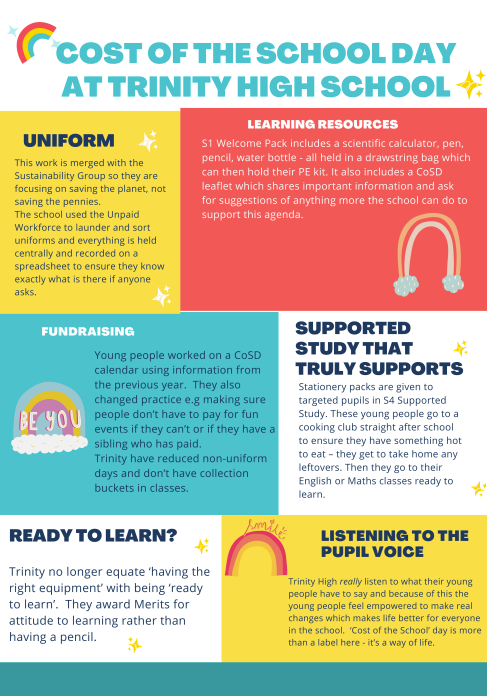To really understand school costs, staff and pupils at Trinity High School in South Lanarkshire have done their homework. Acting Depute Head Teacher (Equity) Adele Simpson worked through the Cost of the School Day Toolkit with staff, engaged with other schools working to reduce the cost of the school day and ran focus groups with pupils and the Parent Council.
As part of a whole-school approach to reducing the cost of the school day, Adele led professional learning with staff on poverty and the cost of the school day, looking at the impact that poverty can have on attendance, engagement and attainment.
“It’s our responsibility as educators to break down those barriers, be sensitive and destigmatise poverty. It also links to the rights of the child as well, which is a powerful national agenda, the right to a quality education.”
Ensuring great experiences for everyone
Adele believes that a young person’s experience of school is not just about the basics.
“So it shouldn't matter how much money you've got, you should be able to access a quality education. And that includes stuff like going to prom or some of these things that some people might think are extras or not part of the basic education. But if you asked anybody ‘what do you remember from school’, what are your happy memories, they’re going to say things like school trips, discos, fun days. And that's the same for our pupils: building positive memories in school contributes to some of our most vulnerable pupils wanting to attend and engage with other aspects of school.”
Staff at Trinity realised that they had to look for ways to make the wider life of the school accessible to everybody. There was a potential discrepancy between different learners' experiences and they needed to find ways to make sure that this wasn’t the case.
Creating a calendar to show cost pressure points
Trinity decided to create a school calendar to highlight costs that weren’t obvious and the support available to pupils and their families to overcome these.
Using the Cost of the School Day calendar as a starting point, the pupil support teacher who was working with Adele gathered together two pupils from each school year, including members of the school's Cost of the School Day pupil group. Adele describes how the support teacher, “would gather pupils once or twice a term, just get them sitting in her office for half a period and just jot down all the expenses they could remember in that half term.”
Young people noted all the expenses that they had incurred over the past half term. These included if they’d had to buy a new notebook, or item of clothing for instance. Adele describes how:
“It was quite personalised for them, but then we as a group went through all the things that they put down over the course of the year, both individual things like stationery and uniform, but also trips, fundraisers and things like that.”

Trinity High School's Cost of the School Day calendar
Producing a calendar for all
As a result of this work, the school's Cost of the School Day calendar now highlights potential costs and how to overcome them. It's worded in a sensitive way and is on the school website and on ParentPortal monthly.
Other Cost of the School Day work at Trinity High School
Trinity High School also produced this great Cost of the School Day infographic, showing the key things that the school does to tackle costs. Their Cost of the School Day pupil group is part of our Voice network and they've taken part in a pre-election event and helped to launch anti-poverty advice for schools.

Trinity High School's Cost of the School Day infographic
A resource you might like
Use the Cost of the School Day calendar to get going and create your own special version for your school.